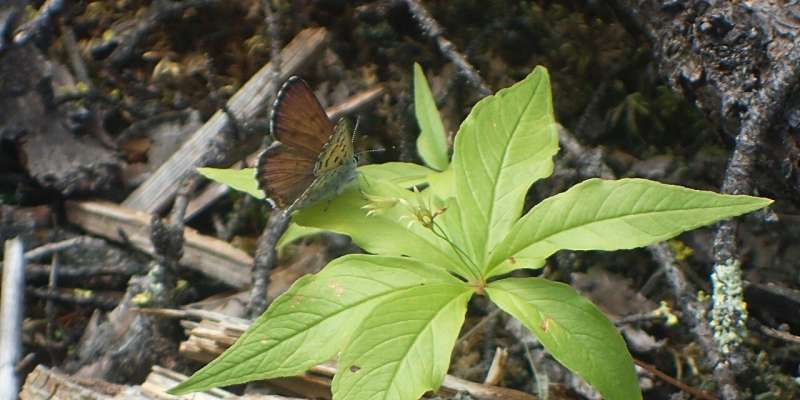Seismic lines helped dozens of butterfly species, including the mariposa copper pictured here, find food and refuge from the wildfire that devastated the Fort McMurray area in 2016, according to a new U of A study. Credit: Federico Riva
Even as Alberta's fierce wildfire raged in and around Fort McMurray in 2016, plants and butterflies were surviving in narrow strips of forest that remained green and undamaged.
Seismic lines, used to locate underground oil reserves, provided refuge from the blaze, said University of Alberta researcher Federico Riva, who outlined his recent findings after studying the area a year later.
Because the cleared corridors provided little fuel for the fire, they stayed almost intact, allowing plants and butterflies to survive "even when the surrounding forest was almost completely burned," said Riva, a post-doctoral fellow.
Of 107 plant and 46 butterfly species Riva observed, most were found to be more common in these corridors than in the neighboring scorched forest,where fire had substantially reduced their abundance.
And because the fire burned less severely inside these seismic corridors—which criss-cross huge swaths of Northern Alberta's boreal forest—nearby forests will, in future, be more easily colonized by the plant and butterfly species that survived in these human-made refuges, Riva noted.
Seismic lines make up about 10 percent of Northern Alberta's boreal forests.
"Without seismic lines, more than half of the ground surface burned, but within these lines only a tenth burned. Most of the original vegetation was still there," said Riva.
Given that climate change is causing forest fires more often than their natural cycle—usually occurring at intervals longer than a century in boreal peatlands—it's important to find out how wildfires, along with other disturbances like seismic lines, affect forest recovery, Riva said.
"There is concern that these forests will not be able to 'bounce back' afterwards; they could reach a point where they won't grow back to their state as we know it, shifting to different forest types."
That in turn affects forest dwellers, he added.
"Changes in the wildfire regime will affect not only the vegetation, but also the critters that inhabit these forests. Presumably, generalist and fire-adapted species will become more common in the future, while species typical of mature forests will become more rare."
Not all species found in seismic lines are typical of mature forests, opening up the question of what long-term effect that could have. Some species that need burned forest, like fireweed, don't benefit from the refuge effect, Riva noted, adding further research is needed.
"Future studies should assess how refuge effects seen in plants and butterflies facilitate other organisms, such as herbivores, within severely burned landscapes, as well as the implications on forest recovery of this widespread pattern of unburned remnants," he said.
More information: Federico Riva et al. Composite Effects of Cutlines and Wildfire Result in Fire Refuges for Plants and Butterflies in Boreal Treed Peatlands, Ecosystems (2019). DOI: 10.1007/s10021-019-00417-2
Journal information: Ecosystems
Provided by University of Alberta























